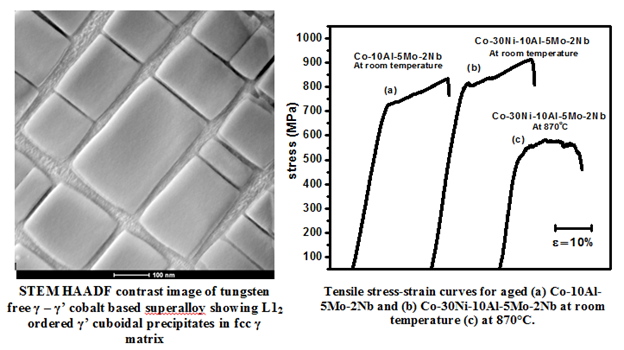In a series of publications, the research group, led by Professor Chattopadhyay has discovered a new class of cobalt based superalloys that are free of tungsten. These alloys having ordered γ’ precipitates in fcc matrix exhibit much higher yield strength both at room temperature and high temperatures (upto 900°C) compared to existing cobalt based superalloys and have potential to compete with nickel based superalloys. Being tungsten free alloys, these newly developed alloys have lower density and possess higher specific strength.

Cobalt based alloys have superior hot corrosion and sulfidation resistance compared to nickel based superalloys due to high chromium content and low diffusion of sulfur in the matrix. But these alloys have much lower high temperature strength due to the lack of stable microstructure unlike nickel based superalloys. This makes them unsuitable for use in hot section parts of the turbine engine. Earlier a Japanese group from Tohoku University reported microstructure similar to the Ni based super alloys by the addition of tungsten (W) in Science (2006). An earlier but less well known report also exist that had been carried out by C S Lee for his PhD thesis in Arizona state university (USA) in 1971. These alloys have similar strength values to that of commercial nickel based superalloys. The main drawback for W containing alloy is the amount of W used (~15 to 25 wt%) that increases dramatically the density of the alloys (>9.8 gm.cm-3). This makes the alloy unsuitable for aircrafts and in applications where the strength to weight ratio is crucial. Since then intense search for a cobalt based alloys with similar microstructure without the presence of tungsten did not yield result.
The present discovery carried out by Surendra and Nithin Baler under the guidance of Professor Chattopadhyay is based on Co-Al-Mo-Nb alloys. This is further fine-tuned by addition of Ta, Ni, Ti, Cr etc. to achieve microstructures that are stable up to 900°C. These superalloys have broken new grounds and some of these alloys show much higher yield strength (> 700 MPa) at 870°C compared to the existing nickel base superalloys and Co-Al-W based alloys mentioned earlier. These have densities in the range of 8.1 to 8.6 gm.cm-3 that is equivalent to nickel based superalloys and much lower than Co-Al-W based alloys.
The elementary results of this class of alloys are published in Acta Materialia (Click here) and Scripta Materialia(Click here).